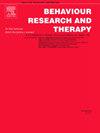Predictors of smartphone addiction in adolescents with depression: combing the machine learning and moderated mediation model approach
IF 4.5
2区 心理学
Q1 PSYCHOLOGY, CLINICAL
引用次数: 0
Abstract
Smartphone addiction (SA) significantly impacts the physical and mental health of adolescents, and can further exacerbate existing mental health issues in those with depression. However, fewer studies have focused on the predictors of SA in adolescents with depression. This study employs machine learning methods to identify key risk factors for SA, using the interpretable SHapley Additive exPlanations (SHAP) method to enhance interpretability. Additionally, by constructing a mediation moderation model, the interactions between significant risk factors are analyzed. The study included 2203 adolescents with depression. Machine learning results from four models (Random Forest, Support Vector Machine, Logistic Regression, XGBoost) consistently identified emotion-focused coping, rumination, and school bullying as the strongest predictors of SA. Further mediation moderation analyses based on the Interaction of Person-Affect-Cognition-Execution (I-PACE) model revealed that rumination significantly mediated the relationship between school bullying and SA, and emotion-focused coping significantly moderated the relationships between school bullying and both rumination and SA. This is the first study to use machine learning to explore the predictors of SA in depressive adolescents and further analyze the interactions among these predictors. Future interventions for SA in adolescents with depression may benefit from psychotherapy that addresses emotion-focused coping and rumination.
抑郁症青少年智能手机成瘾的预测因素:结合机器学习和调节中介模型方法
智能手机成瘾严重影响青少年的身心健康,并可能进一步加剧抑郁症患者现有的心理健康问题。然而,很少有研究关注抑郁症青少年SA的预测因素。本研究采用机器学习方法识别SA的关键风险因素,使用可解释的SHapley加性解释(SHAP)方法来增强可解释性。此外,通过构建中介调节模型,分析了显著风险因素之间的相互作用。该研究包括2203名患有抑郁症的青少年。四种模型(随机森林、支持向量机、逻辑回归、XGBoost)的机器学习结果一致认为,以情绪为中心的应对、反刍和校园欺凌是SA的最强预测因素。基于人-情感-认知-执行(I-PACE)模型的进一步中介调节分析表明,反刍行为显著调节了校园欺凌与SA的关系,情绪聚焦应对显著调节了反刍行为与SA的关系。这是第一次使用机器学习来探索抑郁青少年SA的预测因素,并进一步分析这些预测因素之间的相互作用。未来对抑郁症青少年SA的干预可能受益于以情绪为中心的应对和反刍的心理治疗。
本文章由计算机程序翻译,如有差异,请以英文原文为准。
求助全文
约1分钟内获得全文
求助全文
来源期刊

Behaviour Research and Therapy
PSYCHOLOGY, CLINICAL-
CiteScore
7.50
自引率
7.30%
发文量
148
期刊介绍:
The major focus of Behaviour Research and Therapy is an experimental psychopathology approach to understanding emotional and behavioral disorders and their prevention and treatment, using cognitive, behavioral, and psychophysiological (including neural) methods and models. This includes laboratory-based experimental studies with healthy, at risk and subclinical individuals that inform clinical application as well as studies with clinically severe samples. The following types of submissions are encouraged: theoretical reviews of mechanisms that contribute to psychopathology and that offer new treatment targets; tests of novel, mechanistically focused psychological interventions, especially ones that include theory-driven or experimentally-derived predictors, moderators and mediators; and innovations in dissemination and implementation of evidence-based practices into clinical practice in psychology and associated fields, especially those that target underlying mechanisms or focus on novel approaches to treatment delivery. In addition to traditional psychological disorders, the scope of the journal includes behavioural medicine (e.g., chronic pain). The journal will not consider manuscripts dealing primarily with measurement, psychometric analyses, and personality assessment.
 求助内容:
求助内容: 应助结果提醒方式:
应助结果提醒方式:


